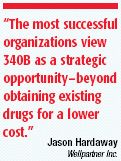How to get more out of the 340B drug discount program
Speakers at the AMCP meeting give suggestions on how more hospitals can make use of the 340B program.

"There has been a significant increase, not only in the interest in 340B, but in the marketplace," explained Harry Hagel, R.Ph., M.S., senior director of the Health Resources and Services Administration (HRSA) Pharmacy Services Support Center (PSSC). "HRSA has stepped up its interest in pharmacy services as it relates to 340B so this is a great time to think about how 340B fits into the pharmacy landscape."
"We've reached a fairly high saturation point in terms of participation," said Hagel. "Most of the entities who do qualify are participating in the 340B program, and we're just now trying to get a handle on to what extent they utilize it." He explained that in 1999, there were 8,000 participating entities and today that number is approaching 13,000. The largest growing areas are disproportionate share hospitals. This is related to the Medicare Modernization Act which changed the calculation parameters, making it possible for 600 to 700 rural hospitals to become eligible for 340B, he said.
According to Jason Hardaway, many pharmacies already enrolled in 340B are underutilizing the program. Hardaway, the director of the Medicaid and 340B programs for Wellpartner, Inc., presented the viewpoint of the enrolled entity at the AMCP session. "When it comes to delivery of pharmacy services, the vast majority of entities have limited knowledge of the 340B program. It's not due to any particular negligence on their part. They simply do not have the resources to have someone run the program full-time. It's an issue of staffing," he said.
Hardaway had suggestions, however, to help entities that may lack the ability to operate their own pharmacies due to pharmacist shortages, state laws that present challenges to do so, or those with inadequate funding. "Entities can contract with an external pharmacy to administer the program, although currently the uptake on this remains relatively low," he advised.
In addition, Hardaway said pharmacies should make sure they are billing non-Medicaid third-party payers at contract rates, focus on attracting patients with third-party payor coverage into the 340B program, and develop collaboratives with payers to expand program participation.
"Entities and payers may be unaware of combined 340B opportunity," he said, adding that the two groups may be willing to share profit margins and should consider developing savings share arrangements if the agreement supports the entity's mission, provides for better outcomes, and generates benefits for patients.
As an example of such, Hardaway described an existing arrangement between a central California entity and a nonprofit managed Medicaid plan where both groups agreed to share margin on prescriptions covered by the payer. The payer provided multiple mailings to its patients and the entity informed them of the 340B contract pharmacy program. As a result, the entity uses revenue generated from the program to provide pharmacy coverage for its uninsured patients and the payer uses savings to make up for state capitation cuts. "The most successful organizations view 340B as a strategic opportunity–beyond obtaining existing drugs for a lower cost," he concluded.
More information on the 340B program can be accessed on the OPA Web site at http://www.hrsa.gov/opa/ or by calling 1-(800)-628-6297.